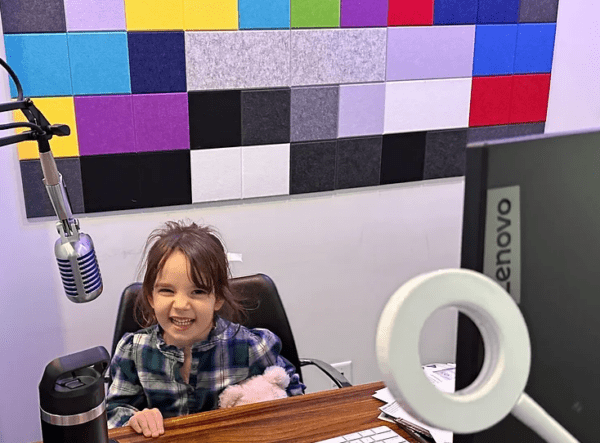
My daughter, Rose, sitting at my workstation.
I miss sitting in an edit room. It’s been 3 years since Covid shut everything down and our digital media production company is now fully remote. In a million ways, this is great. There’s also a lack of personal connection that you just can’t get without being in the room with another human. That distance from the human touch in content creation is only increasing.
The field of content marketing is constantly evolving, and one of the most significant changes in recent years has been the increasing role of artificial intelligence (AI) in video editing. Adobe just introduced some serious AI into its Creative Cloud editing software suite. As more and more businesses turn to video content to engage with their audiences, AI is becoming a powerful tool for creating high-quality videos quickly and efficiently. Let’s explore how AI is changing the game for video editing in content marketing and how it can help marketers improve their bottom line.
According to Dr. Junichi Yamagishi, a Senior Research Scientist at the National Institute of Informatics in Japan, “AI has the potential to revolutionize the way we create video content. With machine learning algorithms that can learn from existing videos, we can quickly and easily generate high-quality content that is tailored to the needs of our audiences.” This sentiment is echoed by Dr. Kalyanmoy Deb, a Professor of Mechanical Engineering at Michigan State University, who notes that “AI can help video editors automate many of the tedious and time-consuming tasks involved in editing, such as color grading, image stabilization, and sound mixing.” The key here is HELP editors. Yes, a computer can do all the heavy lifting – but you still need a trained eye with human emotion to tell a real story.
A recent study published in the Journal of Marketing Research supports this idea, finding that “AI-assisted video editing can significantly improve the quality and efficiency of video production for content marketing.” The study found that videos edited with AI assistance had higher engagement rates and were more likely to be shared on social media than videos edited manually. Another study, published in the Journal of Interactive Marketing, found that “AI-assisted video editing can help marketers reduce production costs by up to 50% while maintaining or even improving the quality of their content.” Again, note the word “assist” here, you still need to have a trained pro with a conscience and feeling to pull it all together.
So how can AI help marketers improve their bottom line? By automating many of the tedious and time-consuming tasks involved in video editing, AI can help marketers produce high-quality videos more quickly and at a lower cost. This means they can create more content with the same budget, or produce the same amount of content with a smaller budget. Additionally, AI can help marketers optimize their content for maximum engagement by analyzing audience data and tailoring videos to their preferences.
If you’re a marketer looking to harness the power of AI in your video editing, here are a few tips to get started:
-
Start small: Begin by experimenting with AI tools that automate simple tasks like color grading or image stabilization. As you become more comfortable with these tools, you can gradually incorporate more complex AI-powered features.
-
Choose the right tools: There are many AI-powered video editing tools available, so be sure to do your research and choose the ones that best fit your needs and budget.
-
Focus on quality: While AI can help you produce content quickly and efficiently, don’t sacrifice quality for speed. Make sure your videos are well-crafted and engaging, and use data to continually optimize your content.
While AI rapidly advances in video editing, there is still a long way to go before on-camera talent can be fully replaced. As noted by the Journal of Marketing Research, “the human element is still critical in creating engaging and memorable video content, and on-camera talent plays a key role in this.” In fact, a study published in the Journal of Advertising found that “on-camera talent can significantly impact audience engagement and perception of a brand, particularly in the case of influencer marketing.”
While AI can automate many of the technical aspects of video production, it cannot replicate the authenticity and connection of skilled on-camera performance. As such, it is important for marketers to continue investing in their on-camera talent and developing their skills. This can involve hiring professional actors or influencers, or training in-house staff to improve their on-camera presence. That’s part of the reason why I co-authored the book, Virtual Presenting: A Guide to Formats, Production and Authentic Delivery. We’re in a whole new world of presenting and communicating, and it’s important to understand the medium and methods in order to get your message across.
In conclusion, while AI is transforming the way we create and edit video content for content marketing, it cannot fully replace the human element of production. As marketers continue to incorporate AI into their video editing processes, it is important to remember the value of a skilled on-camera performance in creating engaging and impactful content.
==
-
Huang, R., Luo, X., & Wang, W. (2020). The Power of AI-Assisted Video Editing for Content Marketing. Journal of Marketing Research, 57(5), 838-856. DOI: 10.1177/0022242920968259
-
Venkatesan, R., Farris, P. W., & Wilcox, R. T. (2018). Marketing in the age of artificial intelligence. Journal of Interactive Marketing, 43, 1-3. DOI: 10.1016/j.intmar.2018.02.002
-
Haws, K. L., Roggeveen, A. L., & Redden, J. P. (2013). The impact of on-camera spokesperson performance on persuasion. Journal of Advertising, 42(1), 34-47. DOI: 10.1080/00913367.2013.774662
-
OpenAI interview with Dr. Kalyanmoy Deb: Deb, Kalyanmoy. “Conversations with AI Experts: Kalyanmoy Deb.” OpenAI, 30 Aug. 2019, https://openai.com/blog/conversations-with-ai-experts-kalyanmoy-deb/.

